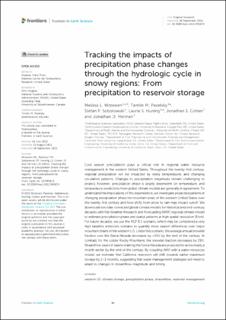| dc.contributor.author | Wrzesien, Melissa L. | |
| dc.contributor.author | Pavelsky, Tamlin M. | |
| dc.contributor.author | Sobolowski, Stefan Pieter | |
| dc.contributor.author | Huning, Laurie S. | |
| dc.contributor.author | Cohen, Jonathan S. | |
| dc.contributor.author | Herman, Jonathan D. | |
| dc.date.accessioned | 2023-09-20T07:40:53Z | |
| dc.date.available | 2023-09-20T07:40:53Z | |
| dc.date.created | 2022-11-21T09:00:17Z | |
| dc.date.issued | 2022 | |
| dc.identifier.citation | Frontiers in Earth Science. 2022, 10 . | en_US |
| dc.identifier.issn | 2296-6463 | |
| dc.identifier.uri | https://hdl.handle.net/11250/3090664 | |
| dc.description.abstract | Cool season precipitation plays a critical role in regional water resource management in the western United States. Throughout the twenty-first century, regional precipitation will be impacted by rising temperatures and changing circulation patterns. Changes to precipitation magnitude remain challenging to project; however, precipitation phase is largely dependent on temperature, and temperature predictions from global climate models are generally in agreement. To understand the implications of this dependence, we investigate projected patterns in changing precipitation phase for mountain areas of the western United States over the twenty-first century and how shifts from snow to rain may impact runoff. We downscale two bias-corrected global climate models for historical and end-century decades with the Weather Research and Forecasting (WRF) regional climate model to estimate precipitation phase and spatial patterns at high spatial resolution (9 km). For future decades, we use the RCP 8.5 scenario, which may be considered a very high baseline emissions scenario to quantify snow season differences over major mountain chains in the western U.S. Under this scenario, the average annual snowfall fraction over the Sierra Nevada decreases by >45% by the end of the century. In contrast, for the colder Rocky Mountains, the snowfall fraction decreases by 29%. Streamflow peaks in basins draining the Sierra Nevada are projected to arrive nearly a month earlier by the end of the century. By coupling WRF with a water resources model, we estimate that California reservoirs will shift towards earlier maximum storage by 1–2 months, suggesting that water management strategies will need to adapt to changes in streamflow magnitude and timing. | en_US |
| dc.language.iso | eng | en_US |
| dc.rights | Navngivelse 4.0 Internasjonal | * |
| dc.rights.uri | http://creativecommons.org/licenses/by/4.0/deed.no | * |
| dc.subject | Nedbør | en_US |
| dc.subject | Precipitation | en_US |
| dc.subject | Vannressursforvaltning | en_US |
| dc.subject | Water Resources Management | en_US |
| dc.title | Tracking the impacts of precipitation phase changes through the hydrologic cycle in snowy regions: From precipitation to reservoir storage | en_US |
| dc.title.alternative | Tracking the impacts of precipitation phase changes through the hydrologic cycle in snowy regions: From precipitation to reservoir storage | en_US |
| dc.type | Peer reviewed | en_US |
| dc.type | Journal article | en_US |
| dc.rights.holder | © 2022 Wrzesien, Pavelsky, Sobolowski, Huning, Cohen and Herman | en_US |
| dc.description.version | publishedVersion | en_US |
| cristin.ispublished | true | |
| cristin.fulltext | original | |
| cristin.qualitycode | 1 | |
| dc.identifier.doi | 10.3389/feart.2022.995874 | |
| dc.identifier.cristin | 2076984 | |
| dc.source.journal | Frontiers in Earth Science | en_US |
| dc.source.volume | 10 | en_US |
| dc.source.pagenumber | 21 | en_US |
| dc.relation.project | Andre: (INFEWS) grant CNS-1639268 | en_US |
| dc.relation.project | Andre: Coupled Natural and Human Systems (CNH) grant 2009726 | en_US |
| dc.relation.project | Andre: University of Texas at Austin, allocation TGATM19008 | en_US |
| dc.subject.nsi | VDP::Geofag: 450 | en_US |
| dc.subject.nsi | VDP::Geosciences: 450 | en_US |

